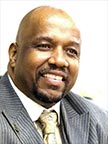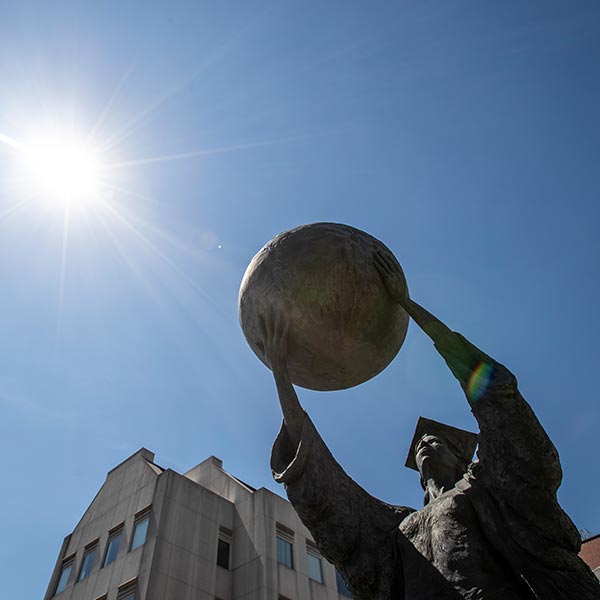Author Note
Tyrone Bledsoe, Sr., Student African American Brotherhood.
On behalf of the thousands of young men and many other key stakeholders within the SAAB national network, I am very appreciative of the invitation to submit this article.
Correspondence regarding this article should be addressed to Tyrone Bledsoe, Sr., Founder/CEO, Student African American Brotherhood, National Headquarters, P.O. Box 1961,
Springfield, MO 65801. Phone: (419) 837-3650. E-mail: tbledsoe@saabnational.org
We Invest in What We Care About
During the mid to late 1960s, Martin Luther King, Jr., paid several visits to my small hometown of Grenada, Mississippi, about 100 miles south of Memphis, Tennessee, to promote African American voter registration and to help desegregate Grenada’s public schools. I was one of the young people profoundly influenced by those life-changing visits.
There is a direct line leading from King’s time in our rural town of Grenada during the contentious civil rights era to the new location of the Student African American Brotherhood (SAAB) headquarters in Springfield, Missouri, more than 50 years later. In the aspirational group I founded, SAAB, or Brother-to-Brother, is an organization devoted to helping young men of color finish high school and get into college, ensuring that they graduate, and encouraging them to extend a helping hand to others and give back to their community. SAAB embraces an ecological framework recognizing that the fate of young men of color is not solely in their hands. We teach our young men that they are a part of a larger community that must be conscious of its capacity to change the systems and conditions of which it is a part, and they must take ownership as they promote practices, policies, and behaviors for improving opportunities for themselves as well as for others.
Like King, I believe that, with the help of organizations like SAAB, we can make a breakthrough in solving the quandary of how best to address the social and educational ills—especially those of young men of color—that have bewildered educators, researchers, sociologists, practitioners, and community stakeholders for decades. My belief is supported by real-world, data-driven results. As an initiative that I began in 1990 with one group of students, SAAB has now impacted thousands across the United States.
To solidify our participants’ continued engagement, SAAB formally launched an Alumni Association in July 2018. This robust network of past and present members ensures that SAAB fulfills its mission: to create and foster a supportive brotherhood in which young men help and care about one another to achieve lives of purpose and success.
Our Idea
SAAB’s main objective is to shape young men to become contributing citizens who will serve as current and future leaders. Given that service is the cornerstone of our organization, we encourage our members to embrace a shared commitment to service with their respective community while, at the same time, espousing SAAB’s four core values: accountability, self-discipline, proactive leadership, and intellectual development. Our organizational ethos echoes the philosophy of “giving back,” which many powerful civic organizations such as Rotary, Kiwanis, United Way, and many others share.
Despite the historic challenges we have faced this year related to COVID-19 and social injustices, many nonprofit leaders and social entrepreneurs have deemed SAAB a game changer in providing the type of healing needed for our country, especially young males of color. Over the years, SAAB stakeholders have been awed by our students, who continue to rise to confront challenges appropriately, peacefully, and head on for their respective community, with a goal of shaping a caring community while valuing and validating everyone. We continue to grow in the face of converging and entrenched winds of injustices and a global pandemic. Our efforts to mobilize a generation of diverse, compassionate, and engaged young males of color are vital.
We maintain that in order to succeed in college and in life, young men of color need more than affirmative action and financial support. SAAB provides the guidance, encouragement, and social support that young men need to define, pursue, and complete their higher education objectives and advance into promising careers. This is no small challenge. Among students who enter college, research has shown that only 33% of Black men earn a bachelor’s degree within 6 years, compared with 57% of White men. SAAB was established to directly address such disparities.
We feel that young men of color, like others in their community, must develop an understanding of what it means to support and be members of that community. Our students drive their own experience. We challenge them to be a part of the solution within their schools and larger communities by manifesting a “brotherhood” of young men committed to lifelong leadership, community service, and civic engagement. We challenge school and institutional administrators to ensure that efforts are increased to educate SAAB participants about the privileges and obligations of citizenship, as well as the importance of tolerance and civic responsibility. Our young men take responsibility socially, and they hold each other accountable to being exemplary members of their community. Through experiential learning opportunities that increase their connections to the community and their understanding of the common good, they create a positive peer community of upwardly mobile males of color committed to caring. Our research has shown that caring is vital to the SAAB experience in that one must care about one’s “self” before one can genuinely and authentically care about others.
SAAB distinguishes itself from other similar groups (e.g., fraternities) in that to become a member, one must willingly accept the charge to be a role model in the community. Our members are deemed polite, sincere, hardworking, and encouraging because they realize that these characteristics are counter to the popular but inaccurate and offensive image of young men of color in America. Furthermore, our members are strongly encouraged to tutor and mentor middle and high school students as a way to impart the same caring spirit that SAAB seeks to instill in them.
Our Challenge
Colleges and universities around the country are trying an array of approaches to helping students persevere and achieve their goals. Some use intensive advising to help students choose the courses they need to stay on track for their majors and to complete their degree on time. Others offer robust academic support to ensure classroom success, while others focus on keeping students’ financial woes at bay.
Males of color experience such a cacophony of social ills that in SAAB’s earlier years, civil rights leaders began openly referring to them as at-risk and endangered. SAAB targets young men of color directly to create a comprehensive social support system built on the values of service, discipline, leadership, and accountability. Our young men model success and make it okay to look, speak, act, and dream differently. Through our efforts to teach them the importance of being responsible change agents in their community, we build networks at individual colleges and schools, and provide a national structure linking students while they are in school and keeping them connected to one another and their respective community after they graduate. We even reach into high schools to activate those students’ aspirations to attend college and to get involved in the community. We are known for having the audacious ultimate goal of changing the national conversation about race and diversity. We are explicit in our belief that guiding young men of color to higher educational attainment and subsequent career success will help erase the divide our society has suffered for so long.
The “SAAB effect” on high school and college persistence has been substantial and sustained. While, on average, 40% of all Black students attain a bachelor’s degree in six years or less, SAAB members have an 80% persistence (i.e., retention) rate over the typically fraught first to second year, and that same group has an impressive 6-year graduation rate of 86%.
These same students experience a special type of social isolation because they are raised with continual social messages that suggest they are undeserving and/or dangerous. The media is replete with stories about “unidentified black and brown males” committing crimes. This criminalization of these young men ostracizes them in ways that breed a resentment of their own identities and a narrative that perpetuates negative stereotypes about them. A clear and tragic consequence of these stereotypes is a sense that no one cares about them. Thus, the primary reason these young men tell us they join street gangs is that “the gang cares about me.”
While some social programs focus on secondary education, preventing gang adherence and ensuring graduation at the high school level, there is an acute need to ensure college graduation and success for the few who do attend since they will become the role models and the hopeful social entrepreneurs for the next generation. The social system must aim higher given that college graduation rates are only slightly higher than high school statistics. SAAB guarantees our participants emotional and academic success compared with similar groups that only fulfill a social role for them. We maintain strict membership requirements unrelated to entertainment or sports in light of our primary focus on academic excellence and degree attainment.
Our Strategy
Almost 15 years ago, we established our national headquarters in Toledo, Ohio. Now nearing our 30th year, we have more than 350 chapters in 40 states, with over 12,000 college and high school student members. As our efforts have expanded to develop a stronger system of community support for our participants, we have added elements of service, not only to the chapters’ home communities, but also to making the chapters thrive by linking to and building on community strengths and accessing resources and abilities that can be deployed. We are more bottom-up than top-down. Each chapter writes its own strategic plan—in collaboration with its university, college, or school advisor partner—to realize individual goals and recognize what works best for its members. Running the chapters is part of training for success beyond college, especially as it relates to preparing participants for the workforce.
SAAB is one of the most venerable, culturally sensitive organizations of its kind and aims to increase the number of Black and Latino men who graduate from college by creating a positive peer community based on a spirit of caring. SAAB is now at a critical juncture as it prepares strategically for the next era of work, particularly as we continuously seek to challenge the status quo of traditional models by finding ways to innovate and develop creative solutions to addressing one of our country’s most pressing problems as it relates to preparing males of color for the postsecondary educational experience. SAAB’s overarching goal is to improve retention and graduation rates of its participants in order for them to gain successful entry into the 21st-century workforce.
In the country’s current landscape, national attention on the development and support of males of color is at its highest levels. This interest is reflected in campaigns and organizational efforts across educational institutions and nonprofit/philanthropic and governmental sectors. Such efforts are coupled with a shifting focus in the educational sector from the admission of diverse populations to more robust efforts to increase retention and graduation rates among the population. In addition, educational institutions, in particular, are actively seeking to support efforts that increase educational attainment and expand economic opportunity for underserved and low-income communities. These focus areas reflect a desire to advance national competitiveness in the global market and improve the standard of living for individuals and communities across the nation. There is a particular focus on improving these areas by building the capacity of educational institutions to adequately support low-income and underrepresented students, and by creating effective and successful educational pathways.
Having learned significant lessons of resiliency over the past 9 months, SAAB is in a unique position to capitalize on current trends, given our mission to help young men excel academically, socially, culturally, professionally, and in the community. One influential philanthropic professional described SAAB as one of our nation’s “top 5” males-of-color-focused organizations. While there are questions about the sustainability of current national efforts to support males-of-color initiatives in general, the current sociopolitical climate represents an opportunity for SAAB to raise its organizational profile and influence the institutions that recognize and value the assets of males of color across sectors throughout the country. We have come to recognize that SAAB students must engage other community members, leaders, and students through community education, awareness raising, and engagement efforts centering on coalition-building activities like town hall and civic organization meetings, and connections with local churches.
SAAB engages young males of color as a community of concerned stakeholders committed to teaching one another social responsibility through peer mentoring, mentoring younger students, and belonging to an intentional community of empathetic and contributing citizens who own and exemplify social responsibility and commitment to their community by amplifying our motto: “I am My Brother’s Keeper, and together we will rise.” The first part of this phrase is a reversal of a biblical betrayal. In the story of Cain and Abel, Cain kills his brother Abel and is asked of the latter’s whereabouts by their father. Cain replies carelessly, “Am I my brother’s keeper?” SAAB members declare that they are, in fact, responsible for one another. We have found that it is important to instill a sense of community ownership within the infrastructure of our organizational culture to drive the type of cooperation from our students necessary to yield a willingness within them to go above and beyond on a daily basis.
This positive sense of belonging is emotionally stabilizing and inspiring as well. The second part of our motto is an affirmation of that togetherness and a denial of the death knell sounded against Black and Brown males during SAAB’s early days. The metaphor of rising is synonymous with achieving true freedom, which can seem unattainable in the current culture. SAAB members live out this creed through regularly scheduled teachable moments and by working collaboratively with community service projects to directly address ills that are impacting them and are affecting a culture that is bereft of leadership and positive peer pressure.
Our graduates/alumni are active and empowered citizens with the capacity to share their powerful gifts of caring and responsibility with others. They are our future and continuously represent the promise for a community that is starving for their leadership. As we often ask our young men at different stages throughout their SAAB experience: Who will benefit from who you are destined to become? Or, in the words of Martin Luther King, Jr., “What are you doing to help others?”
Author
 Dr. Tyrone Bledsoe is an educator with 34 years of high-quality postsecondary education experience. He is the founder and current CEO-President of the Student African American Brotherhood (SAAB) Organization—-a national organization with over 355 chapters in 41 states that endeavors to instill a “spirit of care” and enhance the experiences of young males of color in our country.
Dr. Tyrone Bledsoe is an educator with 34 years of high-quality postsecondary education experience. He is the founder and current CEO-President of the Student African American Brotherhood (SAAB) Organization—-a national organization with over 355 chapters in 41 states that endeavors to instill a “spirit of care” and enhance the experiences of young males of color in our country.
He is the co-author of the book “African American Men in College”. In 2001, he was invited to serve as guest lecturer at the Oxford University Roundtable Institute in Oxford, England. Former President Bill Clinton invited him to participate in the “Clinton Global Initiative” (CGIAmerica) in Chicago (June 2011) to help shape discussions on how the U.S. could strengthen its workforce. In 2015, he invited to the White House and recognized by President Barack Obama to receive the President’s Volunteer Service Award.

